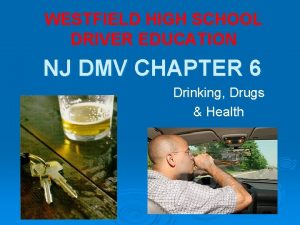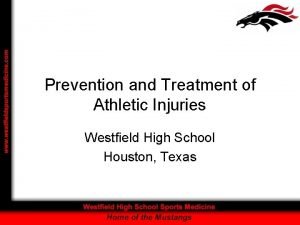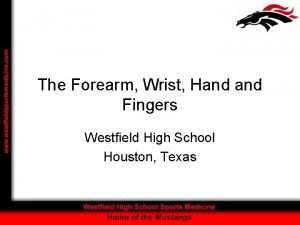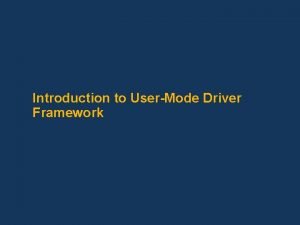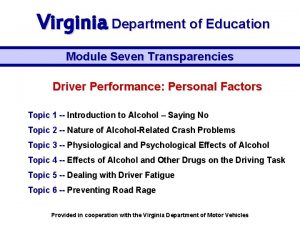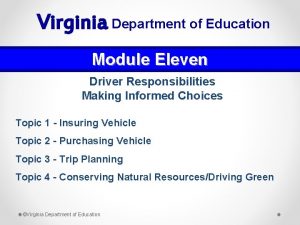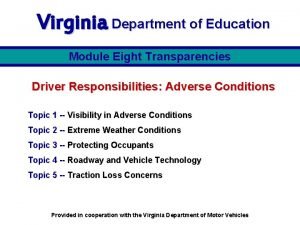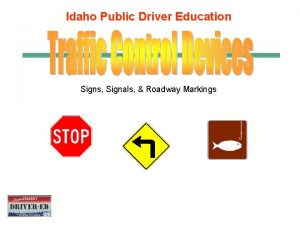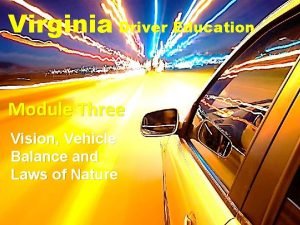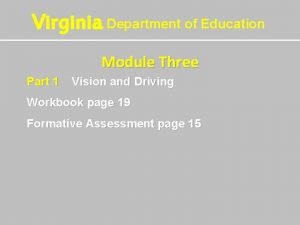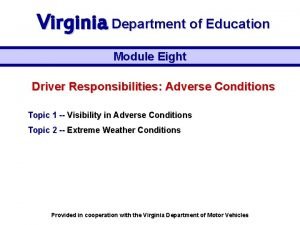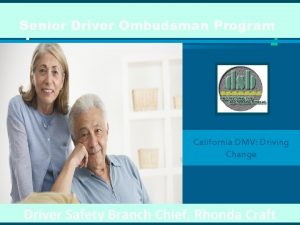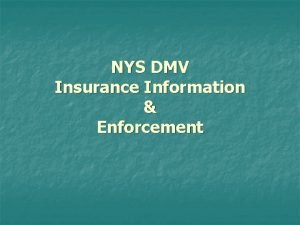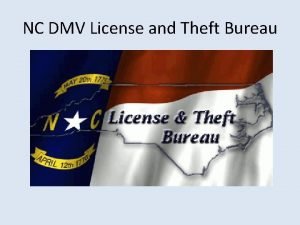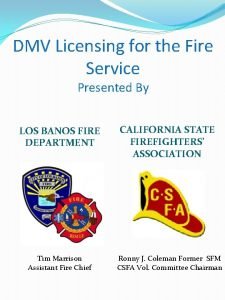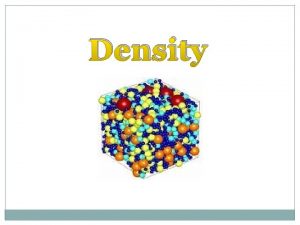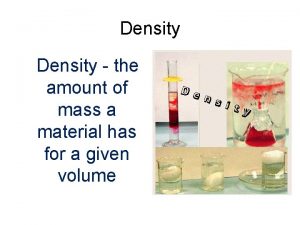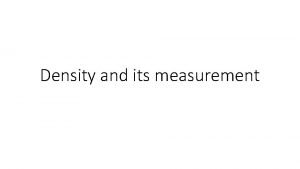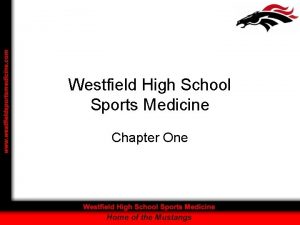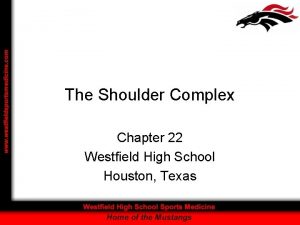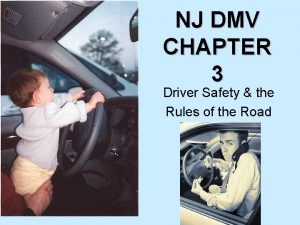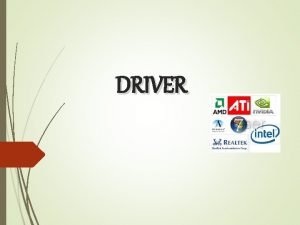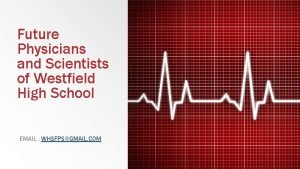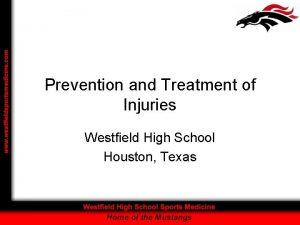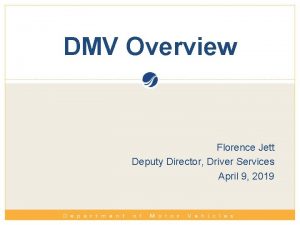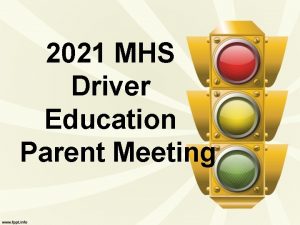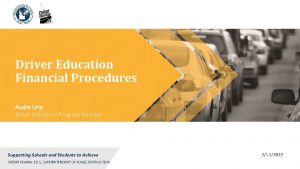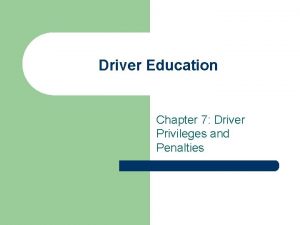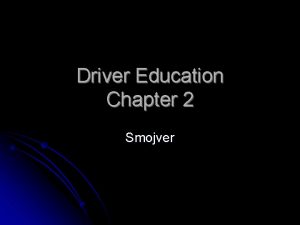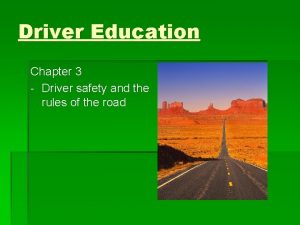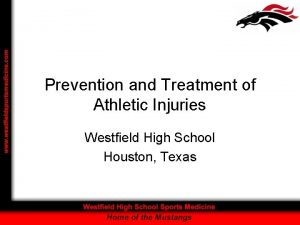WESTFIELD HIGH SCHOOL DRIVER EDUCATION NJ DMV CHAPTER


































- Slides: 34

WESTFIELD HIGH SCHOOL DRIVER EDUCATION NJ DMV CHAPTER 6 Drinking, Drugs & Health

Effects of Alcohol Ø Alcohol is a drug that affects overall driving ability. Ø Alcohol may make a motorist overconfident and unable to think clearly. Ø Motorists who drink may make more mistakes. Ø Even if a motorist thinks he/she is below the level of legal intoxication, alcohol will affect driving. Ø Drinking even a small amount of alcohol increases a motorist’s chances of having an accident.

Ø Driving under the influence of intoxicating beverages means that a driver’s senses and judgment are impaired by alcohol.

Ø After two, three or four drinks, alcohol begins to impair reaction time, coordination and balance. Ø Vision and the ability to judge distance is affected, making it more difficult to react and to drive safely

Ø The only thing that can make a person sober is time. Alcohol is removed slowly by the body. Ø The majority (90 percent) of the alcohol detoxified is oxidized (burned up) by the liver. Ø Ø The other 10 percent is eliminated in breath, urine and sweat. This fact is the prime reason why sober-up-quick methods do not work.


Ø In addition, studies have proven conclusively that a combination of alcohol and anger is responsible for much of the reckless, aggressive driving that can cause fatal highway accidents. Ø While most alcohol-related collisions involve only one vehicle, they frequently result in the death or serious injury of numerous people, including passengers, pedestrians and other motorists.

How Much is Too Much ? Ø The only scientific way to check is through blood alcohol concentration, or BAC. A simple breath test will show a motorist’s BAC. Ø BAC is determined by four factors: • Quantity of alcohol consumed • Body weight • How quickly drinks were consumed • Food eaten

Ø The best way to reduce the risk of a crash caused by drinking and driving is not to drive at all after drinking. Ø In New Jersey, it is illegal for an individual who is 21 years of age or older to drive with a BAC of. 08 percent or higher. Ø For individuals younger than 21, it is illegal to drive with a BAC of. 01 percent or higher. Violators face severe penalties in addition to other penalties assessed for DUI/DWI

Ø If a motorist has reached a BAC of slightly above. 05 percent after drinking, the risk for causing a motor vehicle accident doubles. Ø The risk is six times as great when driving with a BAC of. 10 percent. Ø The risk is 25 times as great when driving with a BAC of. 15 percent.

Ø Note: Under state law, refusal to take a breath test is equal to driving with a BAC of. 08 percent for a first offense. Ø The current penalty for both is the loss of driving privileges for seven months to one year, to run concurrently or consecutively, based upon a judge’s order

Ø Motorists who refuse to take a breath test in New Jersey are also subject to an MVC insurance surcharge of $1, 000 per year for three years. Ø Failure to pay this surcharge will result in an indefinite suspension of driving privileges until the fee is paid

Ø EVERY DRINK CONTAINS ABOUT 1/2 OUNCE OF ALCOHOL. IT’S NOT WHAT YOU DRINK, BUT HOW MANY DRINKS YOU HAVE.

Ø It is important to remember that it does not matter what alcoholic beverage is consumed. Ø There is just as much alcohol in the average beer as there is in the average drink of whiskey or wine.

Ø For example, 1 ½ ounces of 80 -proof whiskey, 12 ounces of beer or 5 ounces of table wine all contain the same amount of alcohol: about ½ ounce of alcohol per drink. Ø Studies show that most people arrested for drinking and driving had been drinking beer.

Ø Although food does slow the absorption of alcohol into the bloodstream, eating will not prevent a high BAC when steadily drinking large amounts. Ø Heavy drinking will always produce a high BAC. Ø Eating does not make a motorist sober. Ø The best way to avoid drinking and driving is to arrange for a designated motorist, use public transportation or call a cab.

Drinking and Driving

Ø Drinking affects a motorist’s thinking and slows reaction time. Ø Alcohol may also give a motorist a false feeling that he/she can do anything. Law enforcement is trained to notice certain telltale signs that a motorist has been drinking:

• Speeding: An intoxicated driver often thinks high speed driving is safe • Weaving: Even though an intoxicated driver may stay in the correct lane, driving straight may be a problem • Slow driving: An intoxicated driver may be overly cautious and drive slower than the normal traffic flow • Jerking motion: An intoxicated driver often may have short mental lapses and not keep a steady speed on a clear road • Quick stops: An intoxicated driver may make sudden stops at a traffic sign or light, rather than easing up to it

Good Hosts and the Drinking Driver Always be a good host. If serving alcohol at a party, always provide alcohol-free drinks and serve nutritious foods or snacks. Never insist that a guest should drink an alcoholic beverage or insist on refills. Ø Stop serving alcohol well before the party ends. If someone drinks too much, do not let them drive. If no other transportation is available, suggest a nap or invite the guest to spend the night. As a last resort, notify the police. Ø Ø Hosts may become involved in a lawsuit if a guest is involved in a drinking and driving collision after leaving the party.

Designated Drivers Ø As the first state in the country to officially launch the Hero Campaign for Designated Drivers, New Jersey encourages all state residents to participate in designated driver programs wherever they travel, whether as a motorist or a passenger.

Ø Being a designated driver is a great responsibility. The designated driver is responsible for the safe transportation of friends or family members who have been drinking alcoholic beverages. Ø Designated drivers not only ensure the safety of the people they are escorting home but also the safety of other motorists.

Ø A motorist who chooses to have a designated driver when attending functions where alcohol will be served shows maturity and consideration for other motorists who share the road.

Drugs and Driving Ø It is illegal to operate a motor vehicle on New Jersey roadways under the influence of any illegal drugs.

Ø The labels on bottles of prescription drugs will describe common side effects.

Ø Drugs that “may cause drowsiness or dizziness” should not be taken before driving. Ø Ask a professional about how over-thecounter drugs may affect driving. Ø Drugs that may affect basic driving skills include cold pills, tranquilizers and some prescription medications

Ø Never mix drugs without asking a medical professional about possible side effects or how the drug may affect driving. Ø Alcohol should never be mixed with any drugs or medications.

Ø If asked, motorists using prescription drugs must show proof of the prescription to law enforcement. Ø If a motorist does not have a prescription for the drug, and a prescription is necessary in order to obtain the drug, the drug will be considered illegal.

Ø After alcohol, marijuana is the drug most often found with drivers involved in collisions. Marijuana use may affect a motorist in the following ways: • Loss of tracking ability: This is the ability to maintain a vehicle in a given line. • Distance judgment: Following too closely can cause problems. • Vigilance: Not remaining attentive to the driving task can cause a motorist to follow too closely, drift into another lane, etc. • Divided attention: Driving is a task that requires constant attention to traffic, roadway and weather conditions, passengers, gauges, etc.

Healthy Driving Health Ø Any health problem can affect an individual’s driving. Ø Even little problems like a stiff neck, a cough or a sore leg can give an individual trouble while driving. Ø If a motorist is not feeling well, he/she should let someone else drive.

Vision Ø Vision is important to safe driving. Most of what a motorist does behind the wheel is based on what he/she sees. Ø State law permits the MVC to retest 10 percent of the driving population each year.

Ø A motorist should have his/her eyes tested every year or two. Ø If over age 40, a motorist should have his/her eyes checked every year for special problems.

Ø Good side vision (peripheral vision) is also essential for safe driving. Side vision helps a motorist see out of the corners of his/her eyes while looking straight ahead. Ø Distance judgment is also an important component to driving. A motorist should know his/her distance from any object while driving. Bad distance judgment often causes accidents.

Hearing is more important to driving than many people think. It can warn a motorist of danger. Ø The sound of horns, sirens or screeching tires warns a motorist to be careful. A motorist may be able to hear a car that cannot be seen. Ø Even people with good hearing cannot hear well if the radio is blaring or he/she is wearing earphones. Ø A motorist should always keep the radio turned down and never wear earphones. Ø
 Dmv westfield nj
Dmv westfield nj John lewis westfield
John lewis westfield Curca westfield state
Curca westfield state Westfield sports injuries
Westfield sports injuries Parenzo invest
Parenzo invest Scaphiod fracture
Scaphiod fracture Westfield
Westfield Westfield referral code
Westfield referral code Pandora chatbot
Pandora chatbot Umdf reflector
Umdf reflector @ginasplug
@ginasplug Module 10 topic 1 drivers ed
Module 10 topic 1 drivers ed Module 7 topic 1
Module 7 topic 1 Module 11 drivers ed virginia
Module 11 drivers ed virginia Module 8 topic 1
Module 8 topic 1 Driver education montana
Driver education montana Warning signs are what shape
Warning signs are what shape Safe driving points balance virginia
Safe driving points balance virginia Lane position 1-4
Lane position 1-4 Module 5 drivers ed virginia
Module 5 drivers ed virginia Module 7 topic 1 distracted driving
Module 7 topic 1 distracted driving Regulatory signs drivers ed
Regulatory signs drivers ed Crescenta valley high school summer school
Crescenta valley high school summer school Haltom high school summer school
Haltom high school summer school How to.find volume
How to.find volume Dmv ombudsman
Dmv ombudsman Ny dmv lapse of insurance
Ny dmv lapse of insurance Nj dmv manual
Nj dmv manual Ncdmv license and theft bureau
Ncdmv license and theft bureau Matter anything that
Matter anything that Dmv triangle
Dmv triangle Ca dmv firefighter endorsement test
Ca dmv firefighter endorsement test Physical density
Physical density Density
Density What does a burette measure
What does a burette measure
